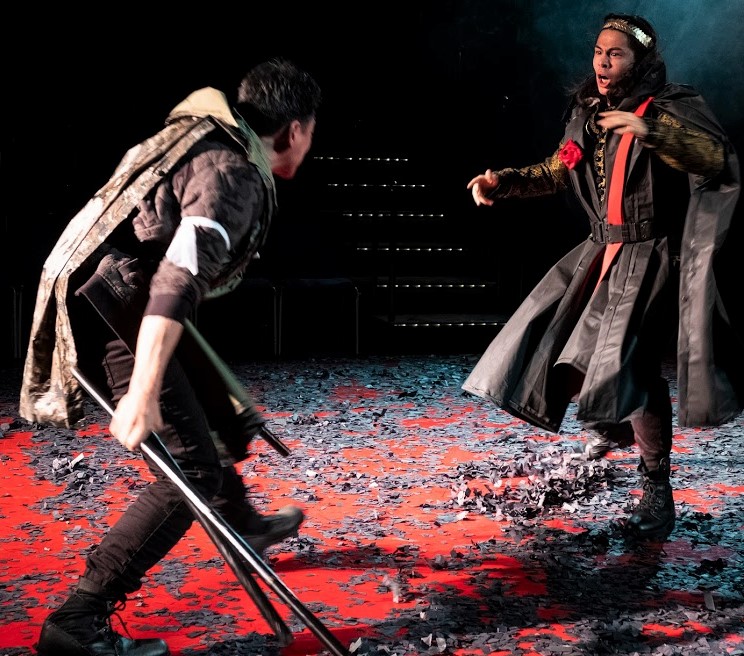Three productions of Henry VI, William Shakespeare’s seldom staged trilogy, have cropped up Off-Off-Broadway since January. The latest, by the ambitious National Asian American Theatre Company (NAATCO), brings epic pageantry and violence to an intimate space at the A.R.T./New York complex.
Three years ago, in an exemplary revival of Clifford Odets’s Awake and Sing at the Public Theater, NAATCO memorably portrayed the disintegration of a Bronx family. With its stirring Henry VI, this resourceful troupe depicts the breakdown of an entire society, which (in the words of W. H. Auden) is “sinking back to a nonsocial herd.”
David Huynh (left) as the Duke of Gloucester (later to be Richard III) and David Shih as King Edward IV in the NAATCO production of Shakespeare's Henry VI. Top: Paul Juhn (left) as George, Duke of Clarence, and Michelangelo Hyeon as Prince Edward. Photographs by William P. Steele.
Henry VI chronicles the end of the Hundred Years War (1337–1453) between England and France and the simultaneous eruption of the War of the Roses. The latter conflict tore England apart for approximately three decades in the second half of the 15th century, pitting followers of the House of Lancaster, who supported the monarch, against the Yorkists, who felt King Henry’s forebears had usurped the throne. The Lancastrians were represented by red roses; the House of York, by white.
Director-adaptor Stephen Brown-Fried has skillfully streamlined the text of Shakespeare’s monumental trilogy, dividing what remains into “Foreign Wars” and “Civil Strife.” The combined playing time of the two parts is just under six hours. (Ticket buyers may choose to see the performances on different days or as a marathon of matinee and evening show on a Saturday or Sunday.)
The production is played in a nearly unadorned black box. Scenic designer Kimie Nishikawa has painted the playing-area floor bright red, but the dazzle of that hue is mitigated by dark-colored paper leaves swept to and fro by the feet of the players as they scurry about the stage. Two staircases, made from rough-hewn timber and readily movable by actors and stagehands, suggest a variety of locations, including the molehill on which Young Clifford (James Seol) and Queen Margaret (Mahira Kakkar) murder the Duke of York (Rajesh Bose).
The simplicity of the scenic design permits swift transitions from scene to scene; and the perspicaciously abridged script keeps this Henry VI moving at a gallop. The final part of the trilogy, which Auden dismissed as “tedious” and “difficult because it portrays complete disorder,” is transformed by Brown-Fried’s judicious editing. As performed by NAATCO, this section focuses compellingly on the villainous Richard Plantagenet (David Huynh), the son of the murdered Duke of York (who will be the title character of Richard III later in Shakespeare’s canon). This ensures that the final hour of the drama has cinematic sweep and a sense of dramatic inevitability consistent with the rest of the production.
Since Henry VI is predominantly concerned with war, it’s appropriate that the most striking physical aspect of this production is its battlefield choreography. The numerous episodes of combat are an imaginative collaboration among Brown-Fried and movement directors Orlando Pabotoy and Kimiye Corwin. Toby Algya’s fierce sound design and Reza Behjat’s sometimes kaleidoscopic lighting punctuate the fight scenes with a variety of aural and visual surprises.
From left: John D. Haggerty as the Earl of Northumberland, Anna Ishida as the Duke of Somerset, and Jon Norman Schneider as King Henry VI.
In the course of the two halves, the 16 actors embody a massive number of roles, with doubling that's always effective and, in several instances, intriguing. All performers aren't equal in technique, but none are markedly weak. And the principals are everything one might hope, with a notably touching performance by Jon Norman Schneider who, as the title character, progresses with reflective nuance from childhood to maturity.
Brown-Fried and his players handle the production’s gender-blind casting with aplomb. Henry VI features three of the most formidable female roles in Shakespeare’s histories—Margaret of Anjou (Kakkar), who becomes England’s war-mongering Queen Margaret; the scheming, diabolical Eleanor, Duchess of Gloucester (Sophia Skiles); and warrior Joan la Pucelle (Kim Wong), who’s also known as Joan of Arc. But it’s heartening in this production to encounter superb actresses taking on meaty nontraditional assignments, such as the Dukes of Gloucester (Mia Katigbak) and Buckingham (Kim Wong), the Earl of Warwick (Vanessa Kai), and the Bishop of Winchester (Wai Ching Ho).
In her formidable performance as Gloucester, Katigbak articulates an overarching theme of the Bard's trilogy: "...these days are dangerous. / Virtue is choked with foul ambition, / And charity chased hence by rancor's hand." The familiar ring of Gloucester's words accounts for producers' attraction to Henry VI this season. In NAATO's straightforward staging, at once intimate and epic, Shakespeare's portrait of long-ago civil dissension serves as an unclouded mirror to the factionalism, deceit, and unreasoned disputation of the present political moment.
The two parts of NAATCO’s Henry VI play through Sept. 8 at A.R.T./New York Theatres (503 W. 53rd St., between 10th and 11th Avenue). Performances of Part I are Tuesdays and Thursdays at 7 p.m. and Saturdays and Sundays at 2 p.m.; performances of Part II are Wednesdays, Fridays, Saturdays, and Sundays at 7 p.m. Tickets are $45 and may be purchased by calling OvationTix at calling (866) 811-4111 or visiting naato.com.





